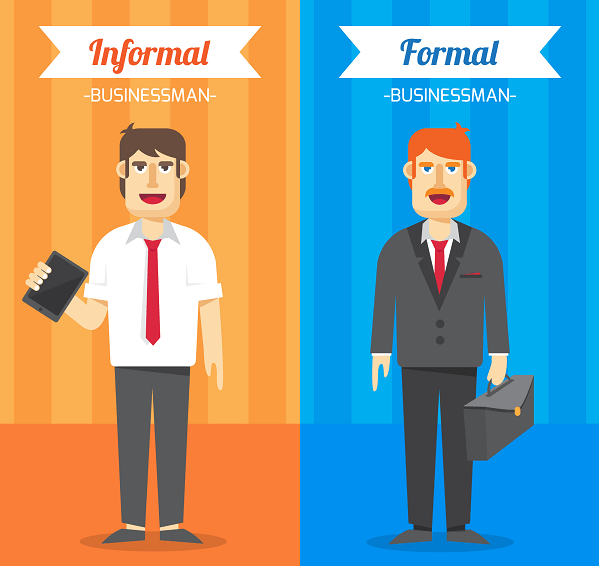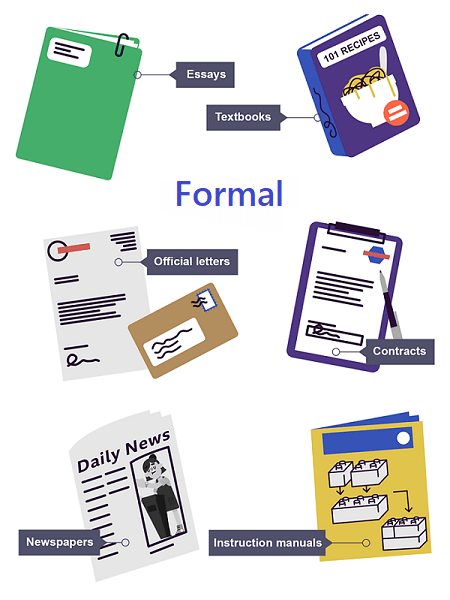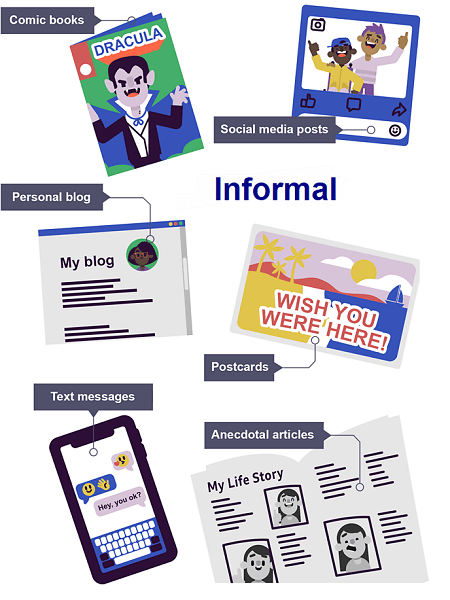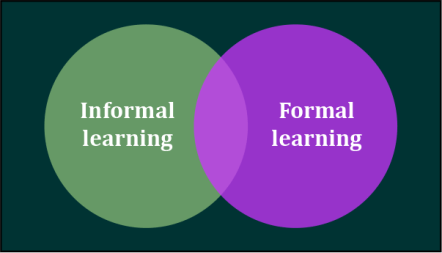Difference between Formal and InformalFormal speech or conduct is precise and sincere in professional settings rather than casual and welcoming. Formal events are unique instances in which guests are expected to dress appropriately and follow established protocols. 
The language used informally and formally has distinct functions. The two writing techniques differ in tone, word choice, and word arrangement. Less intimate than informal language is formal language. It is used when composing for business or scholarly reasons, such as for university tasks. Colloquialisms, abbreviations, and first-person pronouns like "I" or "We" are not used in formal English. Informal speech is less formal and unplanned. It is implemented when interacting verbally or in writing with peers or family. It is used in some professional communication and in private messages sent via text and email. Compared to Formal language, informal language has a more intimate tone. According to the viewer (audience) and the goal of writing, formal and informal words serve various objectives in written interactions. The two distinct writing techniques have differences in priority, word choice, and word placement. Your actions should be aware of when to use formal or informal English at work based on the business, the industry, the audience for which it is intended, and the subject at hand. You presumably speak differently to your peers and relatives than your co-worker or boss at work. There are various protocols in the English language that is suitable for formal and casual or informal situations, similar to those in your native tongue. It's usually a better idea to use formal English whenever possible if you work in a cross-cultural environment or are dealing with individuals you don't know personally or in a friendly manner. This lessens the chance of errors and presents you as a polite and capable individual. FormalFormal writing suggests writer uses a more objective approach, stating the main points and then supporting those points with arguments. Formal writing is less emotional in style, so it avoids things like exclamation marks and emoticons. Standard English forms, proper grammar, and usually shortened phrase patterns are all permissible in formal speaking. Speaking of other formal varieties, formal attire is exquisite and appropriate for formal events. They used regular ties instead of the more conventional high collar and cravat. 
Something done, composed, or examined formally has a very structured, systematic approach. Instruction or teaching with formal approval is given, usually in a school, college, or another establishment. InformalSpeaking or acting informally is more casual and amiable than dignified, authoritative, or professional. Informal speech is more relaxed and unplanned. 
It is used when conversing verbally or in writing with peers or family. It is also applied in some professional communication as well as in private emails and text messages. Compared to formal language, informal speech has a more familiar expression. Everyday clothing is comfortable and appropriate for lounging rather than for formal events. Casual is a term used to characterize actions taken informally or without explicit preparation. Types of FormalThere are eight formal categories which we are going to discuss below:
1. Formal LanguageWhen two people speak in a usually more standard and restrained way, this is known as a formal language. Words, phrases, and grammar constructions that are less frequent in everyday speech are frequently used in formal English. This conveys the information more courteously, respectfully, formally, and polishedly. Formal terminology is implemented in more critical circumstances, like an employment application. When speaking to your lecturer at the institution, ensure that you appear polite and formal. The language used informally and formally has distinct functions. The two writing techniques differ in tone, word choice, and word arrangement. Less intimate than informal language is formal language. It is implemented when composing for business or scholarly reasons, such as educational tasks. Slang, abbreviations, and first-person pronouns like "I" or "We" are not used in formal English. 2. Formal GroupsA formal organization comprises people who have gathered to work toward a single goal. They are always created to fulfill a legal requirement. The administration handles the creation of groups. It has a structured, formal group. The organization's workers are typically split into groups, and each group is given a job to complete. 3. Formal EducationThe word "formal" primarily describes a particular statement that complies with laws and norms by displaying a "formal sanctioning" or "formal approval" in a given situation. The development of highly skilled abilities, mindsets, and principles crucial to a youngster's growth is facilitated by informal and non-formal educational systems. Formal education is an organized, systematic type of instruction. This is the instruction of a specific caliber given to learners by qualified instructors. Organizations oversee formal education in a nation to ensure that it is standardized and that all educational establishments (such as universities, colleges, and other educational institutions) abide by these norms. Specially trained instructors, who are expected to be effective teachers, deliver formal education. Additionally, it upholds attentive control. Both the students and the instructor are conscious of the facts and actively participate in the educational process. 4. Formal OrganisationFormal organization is the traditional framework of clearly specified positions, each carrying a certain amount of power and duty. The management created this administrative framework to carry out a specific job. Each level's role and authority are explicitly specified in formal organizations. It is purposefully made to encourage collaboration to pursue a shared aim. It is a conscious choice made by individuals to achieve targets by abiding by the standards established by the organization. Each employee in this type of company is accountable for their work. It has a structured arrangement of superior-subordinate interactions to accomplish a specified objective. A formal company may have a subdivision or functional organizational framework. 5. Formal CommunicationFormal communication conveys necessary knowledge among individuals who work for the same company but are frequently in different positions in the organizational structure. It is a regulated method of interaction that conforms to pre-set rules, standards, procedures, and laws established by the business and uses specified methods. Formal communication has a top-down, chain-of-command framework, meaning that higher-ranking workers often use it to convey instructions and directives to subordinates. 6. Formal WritingWriting in a formal style is performed to communicate with individuals you don't personally know. It is typically more complex than informal writing. In a professional environment, writing is usually more severe and less casual. In business writing, the author adopts a more impartial stance, outlining the major points and then providing reasons to back them up. Exclamation points and emoticons are not used in formal writing because they are supposed to be more detached in tone. These three short guidelines will help you compose more professionally:
The passive voice should also be used, and lines should be longer and more complicated, according to traditional norms of academic writing style. These guidelines are evolving, though, as it becomes more generally acknowledged that passive voice usage and lengthy, complicated phrases make writing more difficult for readers and comprehend. 7. Formal Dress CodeThis term describes attire appropriate for special occasions, such as marriages, dances, elegant banquets, etc. Formal attire is primarily worn to honor ceremonies for the entertainment business, high school proms, and formal events. The humorously appropriate dress rule for formal wear is a white tie for night-time and a morning dress for midday, even though most people identify formal wear with black tie. Ball dresses or elegant evening (floor-length) costumes are what women are expected to wear. Formal wear includes official military, courtroom, and academic and college attire. 8. Formal LearningAlthough learning is a lifelong procedure, we can't split it into any particular category; it comes from experiences, but we can retain knowledge by understanding other people's experiences, which in this case are probably provided by textbooks, teachers, and other fellow students, which are supplied by formal authorities. Formal learning doesn't particularly need schools or colleges, but it does need the order to follow. Learning that is "provided systematically and purposefully" is formal learning. It is usually arranged and overseen by an instructor and takes place in a face-to-face setting or via online educational aid, like an LMS. Formal learning allows students to attain knowledge in a proper sequence. Consider structured training in the context of new employee orientation or safety training in the workplace. These are seminars that demand planning, have deadlines, and have a specific goal. Three elements that, when combined, make up academic learning are typically included in the idea of formal education:
These fundamental conditions can be extended into a more comprehensive description as follows: Formal learning refers to learning that occurs in places of higher learning that are officially organized, such as colleges, universities, training facilities, etc. Still, it usually depends on students to learn following formal education. Usually, whether or not a real presence at the school is required, it adheres to a specified structure. There are occasionally exact results. Other times, the path or goal is broader. Types of InformalUsed to describe language or conduct appropriate for use with peers but not in formal settings. We should avoid being overly casual and amiable with your staff. There are seven categories that lie under informal, which are listed below:
1. Informal LanguageInformal language is more relaxed and unscripted. It is executed when responding orally or in writing with teammates or family. It is also used in certain kinds of business communication as well as confidential emails and text messages. Compared to formal language, informal language has a friendlier manner. Slang terms may be used in informal language, which is a common, daily language. When we communicate with people, we often employ informal language, and you'll likely find multiple instances of this in your text messages. 2. Informal EducationAn example of informal education is when a parent teaches their kid how to make dinner or pedal a bike. A broad term for education that can take place outside of an organized program is "informal education." Although informal education is not just found in traditional classrooms, it does include student hobbies within a program. It functions through discussion, experience, study, and expansion. Sometimes, but not consistently, there is a clear factual link to some larger image. Giving students the resources they need to master more complicated content is ultimately the aim. It can describe several non-traditional educational practices, including unschooling or parenting, self-teaching, and youth labor. Accidentally and deliberately collaborating to acquire new information is used in informal education. It concentrates on closing the divides between conventional educational environments and living beyond the classroom and maybe discussion-based. The program for casual schooling does not exist. In contrast to formal education, informal education is not delivered by a facility like an educational institution or college. Informal education is not provided on a set schedule. There is no mandated program. Experiences and real life in the family or society make up informal schooling. 3. Informal OrganizationsInstead of a formal division of duties and obligations, the informal organization refers to how an organization functions. The idea of informal organization emphasizes the tendencies of behavior and human connections that emerge within a company but are not represented in an organizational plan or personnel handbook. It clarifies what truly transpires when a group's members carry out (or fail to) their duties. The informal organization may function independently of, concurrently with, or in opposition to the formal organization. According to Chester Barnard (American business executive), an informal organization is a group of encounters between people that need a clear purpose but may lead to expected results. According to Edger Schein (American business theorist and MIT professor), an informal group needs a defined structure, good leadership, a membership list, statutory restrictions, or tangible assets. The social fabric that binds individuals together under a common identity distinguishes an informal group. 4. Informal CommunicationsInformal communication is described as a conversation that takes place outside of the offices, predefined channels. "Grapevine" is another term for a method of informal communication. The informal discussion involves the movement of information in all ways without regard for power or degree. It develops from workplace social encounters and then expands throughout the entire company. It might appear as a story or as gossip. For instance, a casual conversation would be a discussion about a senior's demeanor during lunch. Finding the source of such knowledge is challenging. Additionally, the real conversation may be uneven, resulting in an ending bit of information that is quite distinct from the initial one. Since there is no clear line of authority through which the information travels, an informal conversation is characterized by an indeterminate communication route. Information can therefore come from anywhere. Such communications frequently result from the social connections that people make with others based on shared interests, preferences, or dislikes. 5. Informal WritingInformal speech and writing are appropriate for daily use. It's essentially how we communicate with friends and relatives through messages and writing. It will use vernacular and informal language (phrases implemented in informal but not formal language). The audience might accept some typographical and grammatical errors. As a result, we are more apt to write informally in emails and messages to relatives and close friends. A more casual, informal writing style is also frequently used in websites and other online content. The informal approach to writing is used in pleasant, relaxed conversations and is characterized by the use of everyday words. In informal writing, the viewer is addressed explicitly by the words "you" or "you're," which convey an intimate and passionate tone. It is used when composing private emails, text messages, and notes to loved ones. It is a straightforward style that employs the following:
6. Informal WearThe cloths we use daily are referred to as informal clothing. This fashion places a strong focus on informality, ease, and leisure. It features a variety of outfits and styles. Personal expression and comfort are prioritized over decorum and uniformity when dressing casually. Examples of informal clothing include t-shirts (polo shirts, turtlenecks, etc.), denim, blazers, khakis, sweatshirts, summer dresses, skirts, shoes, slippers, and sandals. Sportswear and clothing used for physical work are also considered informal clothing. You can wear it while traveling, shopping, or just hanging out with buddies. High school and college students wear this look unless the institutions have a particular dress code. Fabrics like cotton, linen, denim, rayon, and fleece are typically used to create casual clothing. Chiffon, brocade, and velour are not costly formal fabrics for casual clothing. Casual attire is inappropriate in offices for special occasions, such as celebrations, marriages, and other formal events, meetings with clients, or work. 7. Informal LearningLearning is the process of converting data and experience into knowledge, abilities, and behaviors throughout a lifetime. However, education is just one method of learning. On the other extreme of the range is informal education. It's unorganized, frequently unplanned, and occurs outside a typical learning environment. Importantly, it is spontaneous, irregular, and self-directed; no actual goals are involved. It may happen whenever and wherever in your company. For instance, a co-worker may say during a conversation that she has discovered a more effective method to systematize a routine procedure that you can also use. Even though it wasn't intentional, you still gained knowledge. Outside of schools and universities, informal learning occurs when a student participates in activities without a specific educational goal in mind. Because it occurs unintentionally and is an essential component of everyday life, informal learning is also called experiential learning. Differences Between Formal and InformalThere are mainly seven key differences between formal and informal discussed below: 
ConclusionWe use formal and informal approaches in our daily lives but in distinct contexts. The professional writing style is appropriate when the subject matter is serious and objective. It is also used when writing to an honorable individual or organization. Like dress code, learning, communication, or education, we have to choose formal or informal according to our surroundings. Informal writing is most appropriate when speaking with members of your family, close friends, and co-workers. Additionally, informal writing can be used if the topic of the debate is not too important and you feel safe speaking casually with the viewer.
Next TopicDifference between
|
 For Videos Join Our Youtube Channel: Join Now
For Videos Join Our Youtube Channel: Join Now
Feedback
- Send your Feedback to [email protected]
Help Others, Please Share










